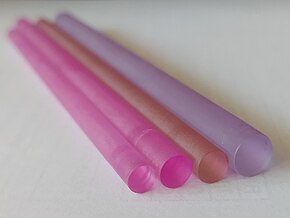
Back وسط ليزري Arabic Medi actiu Catalan Lasermedium German Medio activo Spanish ناحیه فعال لیزر Persian Milieu amplificateur French सक्रिय लेजर माध्यम Hindi レーザー媒質 Japanese 활성 레이저 매질 Korean Aktyvioji terpė Lithuanian

The active laser medium (also called a gain medium or lasing medium) is the source of optical gain within a laser. The gain results from the stimulated emission of photons through electronic or molecular transitions to a lower energy state from a higher energy state previously populated by a pump source.
Examples of active laser media include:
- Certain crystals, typically doped with rare-earth ions (e.g. neodymium, ytterbium, or erbium) or transition metal ions (titanium or chromium); most often yttrium aluminium garnet (Y3Al5O12), yttrium orthovanadate (YVO4), or sapphire (Al2O3);[1] and not often caesium cadmium bromide (CsCdBr3) (solid-state lasers)
- Glasses, e.g. silicate or phosphate glasses, doped with laser-active ions;[2]
- Gases, e.g. mixtures of helium and neon (HeNe), nitrogen, argon, krypton, carbon monoxide, carbon dioxide, or metal vapors;[3] (gas lasers)
- Semiconductors, e.g. gallium arsenide (GaAs), indium gallium arsenide (InGaAs), or gallium nitride (GaN).[4]
- Liquids, in the form of dye solutions as used in dye lasers.[5][6]
In order to fire a laser, the active gain medium must be changed into a state in which population inversion occurs. The preparation of this state requires an external energy source and is known as laser pumping. Pumping may be achieved with electrical currents (e.g. semiconductors, or gases via high-voltage discharges) or with light, generated by discharge lamps or by other lasers (semiconductor lasers). More exotic gain media can be pumped by chemical reactions, nuclear fission,[7] or with high-energy electron beams.[8]
- ^ Hecht, Jeff. The Laser Guidebook: Second Edition. McGraw-Hill, 1992. (Chapter 22)
- ^ Hecht, Chapter 22
- ^ Hecht, Chapters 7-15
- ^ Hecht, Chapters 18–21
- ^ F. J. Duarte and L. W. Hillman (Eds.), Dye Laser Principles (Academic, New York, 1990).
- ^ F. P. Schäfer (Ed.), Dye Lasers, 2nd Edition (Springer-Verlag, Berlin, 1990).
- ^ McArthur, D. A.; Tollefsrud, P. B. (15 February 1975). "Observation of laser action in CO gas excited only by fission fragments". Applied Physics Letters. 26 (4): 187–190. Bibcode:1975ApPhL..26..187M. doi:10.1063/1.88110.
- ^ Encyclopedia of laser physics and technology